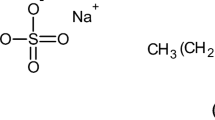Abstract
Human serum albumin (HSA) adsorbed onto silica nanoparticles modified by 3-aminopropyltriethoxysilane (APTES) and polyethyleneimine (PEI) was investigated by differential scanning calorimetry, IR spectroscopy, and photon correlation spectroscopy. The structural alterations of the protein molecules induced from adsorption process were estimated on the basis of temperatures of denaturation transition (T d) of the protein in free (native) and adsorbed form. It was found that adsorption of the protein onto the APTES-modified silica nanoparticles results in an increase in the temperature of denaturation transition from 42 to 47.4 °C. HSA adsorbed onto the PEI-modified silica nanoparticles unfolds extensively.





Similar content being viewed by others
References
Sinha R, Kim GJ, Nie S, Shin DM. Nanotechnology in cancer therapeutics: bioconjugated nanoparticles for drug delivery. Mol Cancer Ther. 2006;5:1909.
Barratt GM. Therapeutic applications of colloidal drug carriers. Pharm Sci Technol Today. 2000;3:163–71.
Couvreur P, Graft R, Andrieux K, Malvy C. Nanotechnologies for drug delivery: applications to cancer and autoimmune diseases. Prog Solid State Chem. 2006;34:231–5.
Ohta KM, Fuji M, Takei T, Chikazana M. Development of a simple method for the preparation of a silica gel based controlled delivery system with a high drug content. Eur J Pharm Sci. 2005;26:87–91.
Song SW, Hidajat K, Kawi S. pH-controlled drug release using hydrogel encapsulated mesoporous silica. Chem Commun (Camb). 2007;42:4396–8.
Roveri N, Morpurgo M, Polazzo B, Parma B, Vivi L. Silica xerogels as a delivery system for the controlled release of different molecular weight heparins. Anal Bioanal Chem. 2005;381:603–6.
Rosenholm JM, Lindén M. Towards establishing structure–activity relationship for mesoporous silica in drug delivery applications. J Control Release. 2008;128:157–64.
Lundqvist M, Sethson I, Jonsson B-H. Protein adsorption onto silica nanoparticles: conformational changes depend on the particles’ curvature and the protein stability. Langmuir. 2004;20:10639–47.
Vertegel A, Siegel R, Dordick J. Silica nanoparticle size influences the structure and enzymatic activity of adsorbed lysozyme. Langmuir. 2004;20:6800–7.
Liu C-G, Chen X-G, Park H-J. Self-assembled nanoparticles based on linoleic-acid modified chitosan: stability and adsorption of trypsin. Carbohydr Polym. 2005;62:293–8.
Liu H, Tian Y, Deng Z. Morphology-dependent electrochemistry and electrocatalytical activity of cytochrome c. Langmuir. 2007;23:9487–94.
Sagvolden G, Giaever I, Feder J. Characteristic protein adhesion forces on glass and polystyrene substrates by atomic force microscopy. Langmuir. 1998;14:5984–7.
Tunc S, Maitz M, Salzer R. Conformational changes during protein adsorption. FT-IR spectroscopic imaging of adsorbed fibrinogen layers gerald steiner. Anal Chem. 2007;79:1311–6.
Buijs J, Norde W, Lichtenbelt J. Changes in the secondary structure of adsorbed IgG and F(ab’) studied by FTIR spectroscopy. Langmuir. 1996;12:1605–13.
Engel MFM, van Mierlo CPM, Visser AJWG. Kinetic and structural characterization of adsorption induced unfolding of bovine α-lactalbumin. J Biol Chem. 2002;277:10922–30.
Koutsopoulos S, vander Ost J, Norde W. Adsorption of an endoglucanase from the hyperthermophilic Pyrococcus furiosus on hydrophobic (polystyrene) and hydrophilic (silica) surfaces increases protein heat stability. Langmuir. 2004;20:6401–5.
Rezwan K, Meier LP, Gauckler LJ. Lysozyme and bovine serum albumin adsorption on uncoated silica and AlOOH-coated silica particles: the influence of positively and negatively charged oxide surface coatings. Biomaterials. 2005;26:4351–7.
Larsericsdotter H, Oscarsson S, Buijs J. Thermodynamic analysis of proteins adsorbed on silica particles: electrostatic effects. J Colloid Interface Sci. 2001;237:98–103.
Tobias DJ, Mar W, Blasic JK, Klein ML. Molecular dynamics simulations of a protein on hydrophobic and hydrophilic surfaces. Biophys J. 1964;71:2933–41.
Norde W. Adsorption of proteins from solution at the solid–liquid interface. Adv Colloid Interface Sci. 1986;25:267–340.
Jin W, Brennan JD. Properties and applications of proteins encapsulated within sol–gel derived materials. Anal Chim Acta. 2002;461:1–36.
Billsten P, Caresson U, Jonsson BH, Olofsson G, Hk F, Elwing H. Conformation of human carbonic anhydrase II variants adsorbed to silica nanoparticles. Langmuir. 1999;15:6395–9.
Vermonden T, Giacomelli CE, Norde W. Reversibility of structural rearrangements in bovine serum albumin during homomolecular exchange from AgI particles. Langmuir. 2001;17:3734–40.
Hughes MA. The structure function relationship of silica polyamine composites. PhD Thesis, The University of Montana, Missoula, MT, USA; 2007.
Kazitsina LA, Kupletskaya NB. Application of UV-, IR- and NMR spectroscopy in organic chemistry. Moscow: High School; 1971.
Lee DC, Haris PI, Chapman D, Mitchell RC. Determination of protein secondary structure using factor analysis of infrared spectra. Biochemistry. 1990;29:9185–93.
Rezaei-Tavirani M, Moghaddamnia SH, Ranjbar B, Amani M, Marashi S-A. Conformational study of human serum albumin in pre-denaturation temperatures by differential scanning calorimetry, circular dichroism and UV spectroscopy. J Biochem Mol Biol. 2006;39:530–6.
Flora K, Brennan JD, Baker GA, Doody MA, Bright FV. Unfolding of acrylodan-labeled human serum albumin probed by steady-state and time-resolved fluorescence methods. Biophys J. 1998;75:1084–96.
Farruggia B, Rodriguez F, Rigatuso R, Fidelio G, Picó G. The participation of human serum albumin domains in chemical and thermal unfolding. J Protein Chem. 2001;20(1):81–9.
Acknowledgments
This study was supported by a grant from Russian Foundation of Basic Research 09-03-97513.
Author information
Authors and Affiliations
Corresponding author
Rights and permissions
About this article
Cite this article
Parfenyuk, E.V., Kulikova, G.A. & Ryabinina, I.V. DSC and spectroscopic investigation of human serum albumin adsorbed onto silica nanoparticles functionalized by amino groups. J Therm Anal Calorim 100, 987–991 (2010). https://doi.org/10.1007/s10973-009-0604-4
Received:
Accepted:
Published:
Issue Date:
DOI: https://doi.org/10.1007/s10973-009-0604-4




